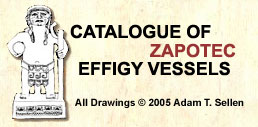| Key: MNA 6-388 |
| Actual Location: National Anthropology Museum, Mexico City, Mexico (exhibited). |
| Collection: Francisco Belmar #62; according to Martínez Gracida (1910: 107), it was found in 1896. |
| Registration: 6-388 or 6-6047 |
| Provenance: Atzompa, Oaxaca. |
| Measurements: 71 x 14 cm. |
| Color: Grey clay with traces of white and red paint. |
| Chronology: Peche 500 - 600 AD |
| Click to view Chronology |
| Reference: No. 62 in Belmar's catalog (AH/ MNA, vol. 11, fs. 17-35); Martínez Gracida 1910: 107; Caso & Bernal 1952: 285, fig. 431, Marcus 1983: fig. 5.11; Solis 1991: 158, fig. 230; Marcus and Flannery 1996: 210, fig. 247. |
| Comments: According to Belmar, the figure represents a man. Martínez Gracida says it represents a "priestess". Caso and Bernal use this vessel to define the category "Goddess 13 Serpent". Caso and Bernal (1952) and also Marcus (1983) published the artifact without origin. Later, Marcus and Flannery (1996: 210, fig. 247) maintained that the provenance was Monte Albán. According to Belmar's Collection list, it comes from Atzompa and was excavated by the collector himself. |
| Glyphs: Glyph 13 V on the chest. |
| Dating: TL by Peter Schaft 1999: authentic (Martha Carmona, personal communication 1999). |
|
